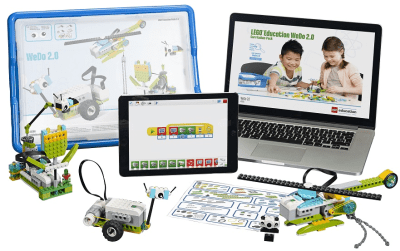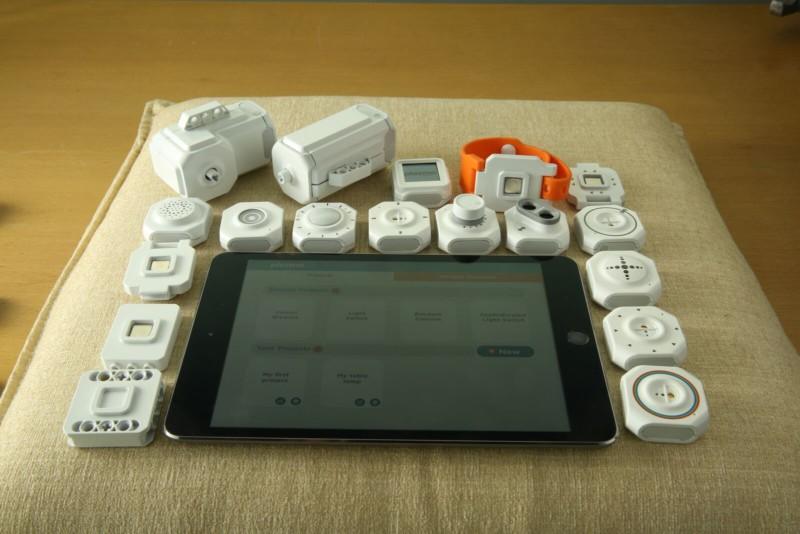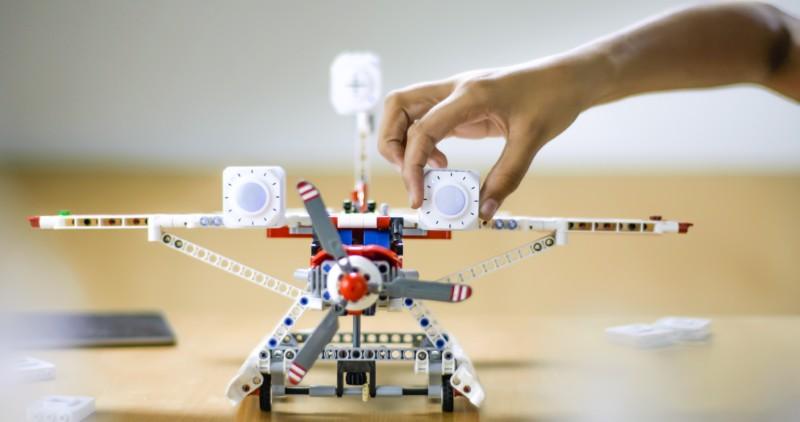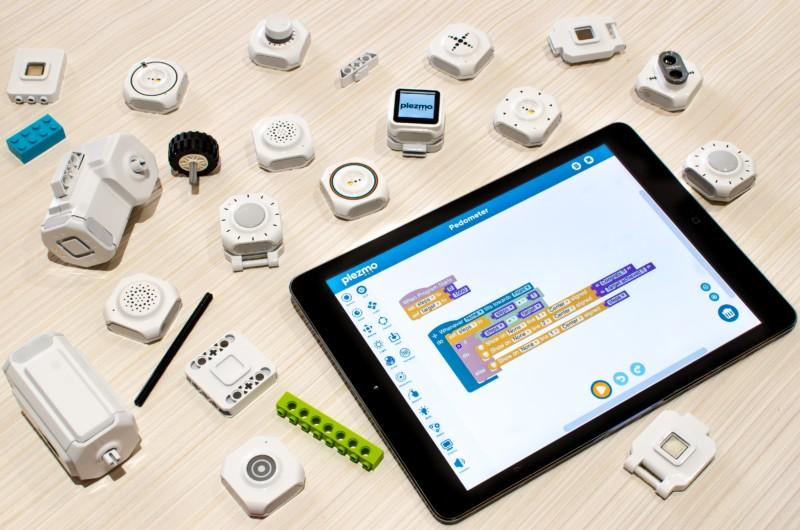Heute wird auf der Consumer Electronics Show (CES) in den USA eine weltweite Innovation vorgestellt:
LEGO® Education WeDo 2.0, ein kabelloses, roboterbasiertes Lernsystem, mit dem schon Grundschüler projektorientierte Problemlösung und Grundzüge des Programmierens erlernen.

Anfassen, ausprobieren, umsetzen – das neue Lernkonzept WeDo 2.0 ermöglicht eine immense Vielfalt bei der Gestaltung eines lebendigen, handlungs- und forschungsorientierten Sachunterrichts in der Grundschule. Unter Einsatz der vielseitigen LEGO Bauelemente, der Software und der Unterrichtsmaterialien arbeiten Lehrerinnen und Lehrer mit ihrer Klasse an wissenschaftlichen Projekten mit lebensechtem Anwendungsbezug und schaffen so ein solides Grundverständnis für alltägliche Phänomene. Schülerinnen und Schüler erlernen durch das Anfassen und Ausprobieren technische, physikalische und biologische Grundlagen sowie die elementare Logik des Programmierens. Sie werden animiert, Probleme zu erkennen und kreative Lösungsansätze zu entwickeln. Die Kompetenzbeschreibungen basieren auf dem aktuellen Perspektivrahmen Sachunterricht. Die Unterrichtsmaterialien von WeDo 2.0 behandeln zentrale Themen des Sachunterrichts und orientieren sich an den aktuellen Lehrplänen der Jahrgangsstufen 2 bis 4 und sind ebenfalls für LehrplanPLUS geeignet.
Im Rahmen der verschiedenen Projekte beschäftigen sich Schülerinnen und Schüler intensiv mit Problemen und Fragen der Wissenschaft, Konstruktion, Technologie und Programmierung und entwickeln dabei Freude am Experimentieren und Untersuchen. Lehrkräfte werden durch Fortbildungen, Unterrichtsmaterialien und integrierte Leistungsbewertungen unterstützt. So ergibt sich ein Unterrichtsmittel, welches Schülerinnen und Schülern dabei hilft, kritisch zu denken und problemlösungsorientiert zu agieren sowie im Kontext zu handeln und zu urteilen. Nebenbei werden die Kommunikation und die Präsentationsfähigkeit gestärkt und die Entwicklung eigener Lernstrategien wird angestoßen. Neben dem Erkenntnisgewinn stehen auch Partner- und Gruppenarbeit im Fokus.
Die dazu gehörenden Unterrichtsmaterialien behandeln wesentliche Themen des Sachunterrichts und orientieren sich am aktuellen Lehrplan der 2. bis 4. Jahrgangsstufe mit 17 Projekten und Stoff für mehr als 40 Unterrichtseinheiten. Schülerinnen und Schüler beschäftigen sich mit wissenschaftlichen Verfahren und technischen Denkweisen, indem sie verschiedene Herangehensweisen und Entwürfe testen. Im „Transport“-Projekt sollen sie beispielsweise ein Gerät entwerfen, das die Auswirkungen eines heftigen Unwetters für Menschen, Tiere und Umwelt einer betroffenen Gegend abmildert. Schülerinnen und Schüler können Lösungen für eigene sowie vorgegebene Fragestellungen entwerfen. Dabei gewinnen sie einerseits Einblicke in die Vielschichtigkeit von Problemen und Systemen, andererseits erkennen sie, dass es bei Problemen unterschiedliche Lösungswege und -verfahren oder auch Antworten geben kann. Das unterstützt die Entwicklung ihrer Kreativität und die Fähigkeit, schwierige Probleme und Aufgabenstellungen eigenständig zu lösen. Zudem können Lehrkräfte mit Hilfe des Materials ihren Unterricht differenzieren und an die unterschiedlichen Lernvoraussetzungen ihrer Schülerinnen und Schüler anpassen.
„Aus unserer Erfahrung suchen Grundschullehrkräfte Lernmaterial, das eine zeitgemäße naturwissenschaftlich-technische Bildung ermöglicht, das auf die Lehrplaninhalte abgestimmt ist und im Unterricht funktioniert. WeDo 2.0 erfüllt diese Voraussetzungen. Obendrein vermittelt es Kindern auf spielerische Weise die Grundzüge des Programmierens und entfacht dabei eine enorme Motivation für das Lernen, Forschen und Entdecken“, kommentiert Prof. Dr. Daniela Schmeinck von der Universität Köln.
Jedes der neuen WeDo 2.0 Sets besteht aus einem LEGO Education Baukasten mit 280 Teilen und Software für iPad, Android, PC und Mac. Die Software wird direkt mit dem Bausatz geliefert und beinhaltet bereits ein Einführungsprojekt. Dieses erklärt Schritt für Schritt die Hard- und Software und zeigt anschaulich deren Einsatz im Unterricht. Die Software mit grafischem Drag&Drop-Interface stellt eine einfache und intuitive Programmierumgebung zur Verfügung, mit der Schüler ab 7 Jahren ihre LEGO Modelle zum Leben erwecken. Sie beinhaltet auch ein Dokumentationswerkzeug, mit dem Schülerinnen und Schüler ihren Problemlösungsprozess erfassen können, und das Lehrkräften eine Möglichkeit zur Leistungsbeurteilung gibt.
Die neue kabellose Plattform beinhaltet zudem ein Bluetooth-Niedrigenergie-Smarthub-Element – einen elektronischen Baustein, der Teil der LEGO Education-Technologieplattform LEGO Power Functions (LPF) ist, einen Motor, einen Neigungs- sowie einen Bewegungssensor.
Eine Scratch-Schnittstelle für WeDo 2.0 (sowohl webbasiert als auch stand alone) für Macs wird im Februar 2016 und für Windows ab Juni 2016 verfügbar sein. Chromebooks werden ab der zweiten Hälfte 2016 unterstützt. Informationen, wie Lehrer LEGO Education WeDo 2.0 in der Schule einsetzen können, finden Sie unter www.LEGOeducation.de.
LEGO Education WeDo 2.0 wird zur unverbindlichen Preisempfehlung von 154,69 € in den nächsten Tagen auf www.LEGOeducation.de/shop erhältlich sein. Die umfassenden LEGO Education WeDo 2.0 Unterrichtsmaterialien kosten 297,49 €. Ein Klassensatz für 24 Schüler kostet beispielsweise 2.106,29 € brutto.
In Deutschland wird das innovative System in Form eines lebendigen Klassenzimmers erstmals von 16.02.2015 bis 20.02.2015 auf der didacta in Köln am Stand C39 in Halle 6 präsentiert!
Über LEGO® Education
Seit über 30 Jahren arbeitet LEGO® Education mit Lehrern und Bildungsspezialisten zusammen, um Lernkonzepte und Unterrichtsmaterialien zu entwickeln, die den Schulstoff lebendig werden lassen und Freude am Lernen vermitteln. Das Angebot von LEGO® Education unterstützt Lehrkräfte im kompetenzorientierten Unterricht in Geistes- und Naturwissenschaften, Technik, Informatik und Mathematik und fördert bei jungen Lernenden das Erlangen von Team-, Kommunikations- und Problemlösungsfähigkeiten. Diese sollen Kinder letztlich dazu befähigen, den sich wandelnden Anforderungen ihrer Lebenswelt gewachsen zu sein und aktiv ihre eigene Zukunft zu gestalten. LEGO® Education hat seinen Sitz in Billund, Dänemark und Büros auf der ganzen Welt. Mehr als 200 Mitarbeiter teilen die Vision, alle Schülerinnen und Schüler für lebenslanges Lernen zu begeistern. Mehr unter www.LEGOeducation.de




